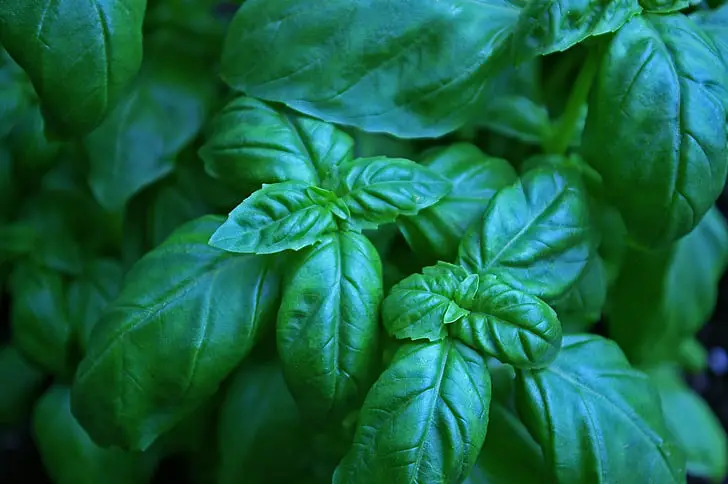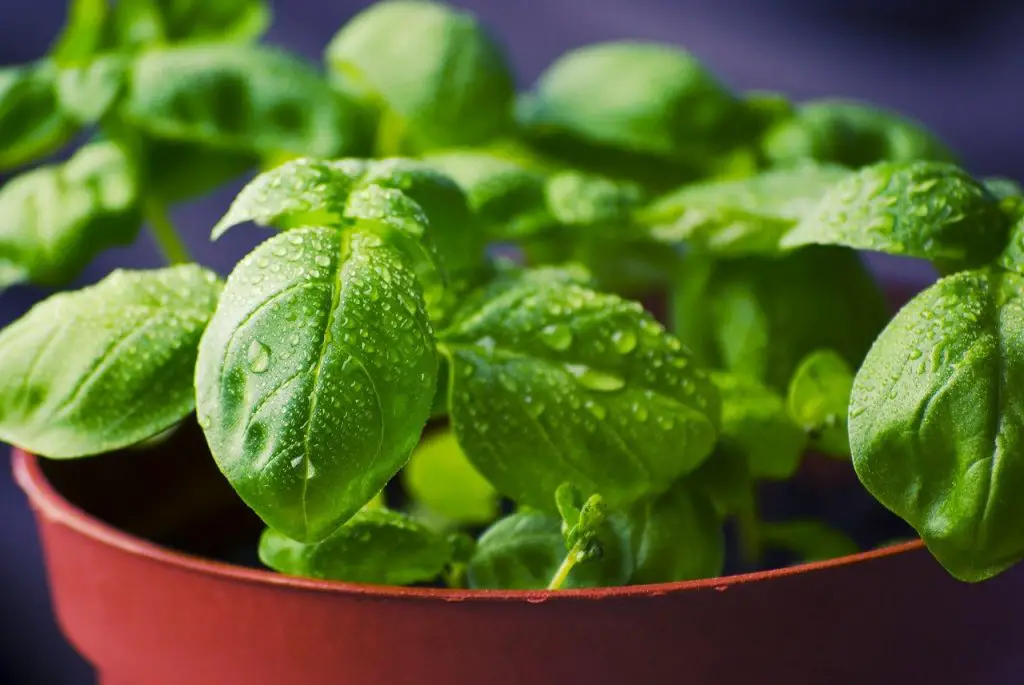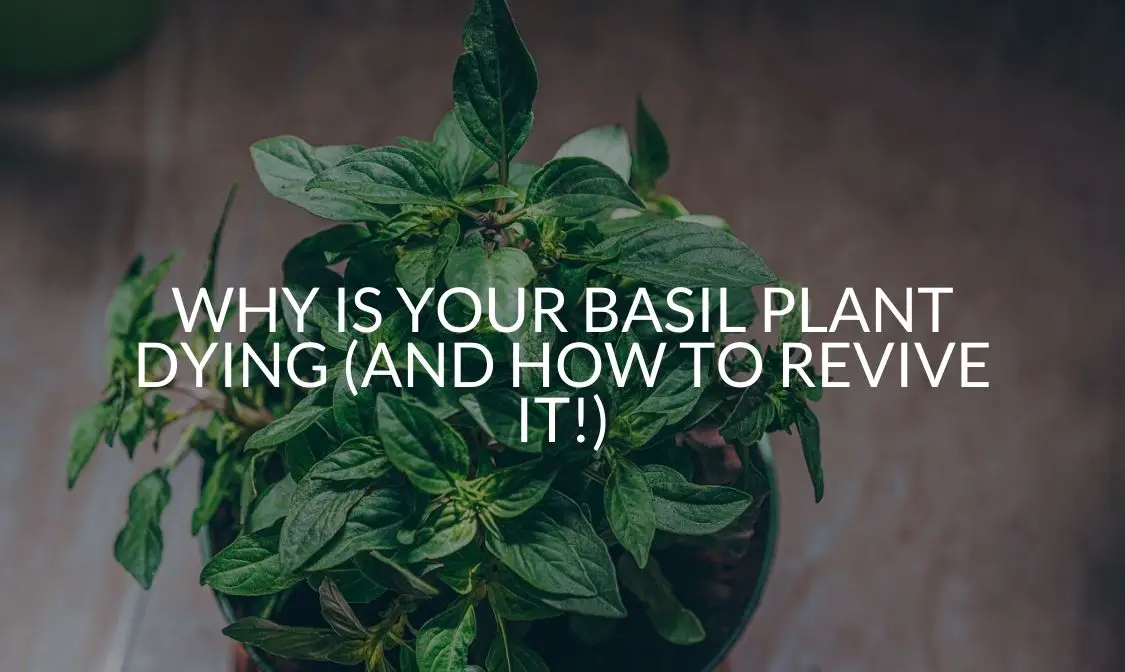Growing your own basil can be incredibly rewarding due to how it provides you with a consistent fresh supply of a tasty herb. However, maintaining the health of your basil plants is imperative.
I remember being told that basil is an easy herb to grow and I was surprised to discover how many smaller details I had missed along the way.
This post covers the reasons why your basil plant is dying, ways you can treat a dying basil plant, as well as methods to prevent your plants from dying in the first place.
Why Is Your Basil Dying?
There are several reasons why your basil could be dying. Identifying what the cause is can help you use the right techniques to bring them back to life (if it isn’t too late!).
Watering Issues
Overwatering my basil plants was the main cause of my issues. While basil requires a good quantity of water to thrive, the roots don’t cope well with too much water.
Basil requires small pockets of air within the soil to breathe properly. When you overwater this plant, the soil becomes soggy and there’s no room for air to circulate. As a result, the roots lose out on vital oxygen which is needed to maintain their health.
If the roots of a basil plant are getting enough oxygen, they’re unable to provide the rest of the plant with nutrients and water. This will lead to a pretty quick downturn in the overall appearance of your basil plant.
When left unnoticed for too long, the damage from overwatering can be irreversible.
However, overwatering may be caused by factors other than you pouring too much water into the soil. Overwatering can happen if the soil in the pot isn’t able to drain the water effectively. Furthermore, if the pot is too large, the soil can take too long to dry, which starves the roots of oxygen.
Always check the soil before watering to gauge a better idea about how much to water it.
Lighting Conditions
When I was growing my basil plant in the kitchen, I neglected the importance of the lighting conditions. Basil plants require consistent light to grow and be healthy.
So, if you’re growing your basil inside, make sure that it’s exposed to enough sunlight. Having said that, my basil leaves started to grow crispy when I left them too close to the window.
Be sure to keep a close eye on the condition of your basil and move it back from the window a little if you think the leaves are getting too crispy due to overexposure to sunlight.
Some of the main signs that your basil plant is suffering due to poor light conditions include:
- Stunted growth
- Overly vibrant leaves
- Yellowing
- Increased leaf droppings
Cold Temperatures
Basil plants and the cold don’t mix well, at all.
It’s best not to expose your basil to temperatures that are under 50°F. When basil is exposed to these low temperatures, it’ll begin to wilt quickly.
Not to mention, evaporation of water doesn’t happen as effectively, which can cause the soil to retain too much water and be a factor in overwatering issues.
If you’re growing your basil plant indoors, the cold temperature shouldn’t be a big issue. Just be sure that the plant isn’t growing next to a window that lets in too much cold air.
When it comes to growing your basil plant outdoors, it’s best to sow the seeds once there’s no frost.
Bug Infestation
Spider mites and aphids are the main bug infestations to look out for. You’ll also want to keep your eyes peeled for slug infestations.
Aphids and spider mites feed on the sap from basil plants which causes them to wilt away. Spots in your basil leaves are a clear indicator that bug infestations are happening. Basil plants become dehydrated and infected when bugs are present.
Spider mites are notorious for multiplying at very fast speeds. So, keep your eyes peeled for small webs around your basil plant to identify what the issue could be.
Wilting
One of the most common forms of disease that I’ve noticed when growing my basil is fusarium wilt. In particular, my sweet basil plants have been impacted the most.
This is because some types of fungi interfere with the channels in the stem of basil plants that deal with transporting water. As a result, the plant is left dehydrated, and wilting often occurs.
Root rot and darker stems are common signs of fusarium wilting.
Fusarium wilt is one of the deadliest diseases for a basil plant and cannot be fixed. Therefore, I’d recommend that you remove the plant from the soil to prevent other plants from being infected.

Why Is Your Basil Plant Dying From The Bottom Up?
Fungi and bacteria are the main causes of root rot. Unfortunately, root rot can be a more serious issue that’s difficult to revert.
Although, your basil can be salvaged if you catch root rot early enough. When the roots of your plant start rotting, removing the roots and repotting is essential to saving the rest of the plant if it’s still in the early stages of rotting.
If you notice the stem becomes brown or feels wetter than usual, this could also be a sign of fungi and bacterial issues that come from the bottom up.
How To Revive A Dying Basil Plant
Retrieving your dying basil plant comes down to the cause. Before diving in and trying out a bunch of fixes, be sure that you’ve taken a close look at the plant and found the root causes.
For example, a basil plant that has been underwatered can be easily fixed by giving it the proper amount of water. However, in cases where the roots have rotted over a long duration of time, reviving the plant is more unlikely.
How To Prevent Your Basil Dying
Now that you have a better idea about some of the main reasons why your basil plants have been dying, let’s take a look at ways you can prevent problems in the first place.
Giving It Enough Nutrients
Basil plants becoming deficient in nutrients is a common issue that can be rectified easily by increasing the amount of fertilizer that you add to the soil. Consider using the following:
- Shellfish
- Compost
- Vermicompost
These fertilizers increase the mineral and nitrogen values within the soil to ensure that the basil is provided with enough nutrients to grow healthily.
I also make sure to replant my basil every 2-3 months. This is to ensure that the soil never gets to the point where it becomes void of nutrients.
Proper Watering
Wilting is a common side effect that occurs when you’ve overwatered your plants. A common sign of dehydrated plants is when the leaves turn yellow and are smaller in size than usual.
Watering dehydrated basil plants is the more effective and easy way to prevent the problem from becoming worse. However, this only works if the cells within the plant haven’t been damaged beyond repair.
I recommend that you create a schedule for watering your plants. This ensures that you can give it a consistent supply of water to never have to deal with underwatering issues. You may also need to increase the amount of water you use during hotter times of the year.
Using The Right Lighting Conditions
Saving basil plants from poor lighting conditions can work if you act quickly enough.
Basil plants that have been in poor lighting for too long may be beyond repair. If the leaves have turned yellow, it may already be too late, but you can still try to expose the plant to lots of light to see how it reacts.
I know some people love using special grow lights that can give basil plants the light they desperately need to flourish. Sometimes, you may simply need to place the pot in a part of the home or garden that has more sun exposure.
Finding The Ideal Temperature
I found that the growth of my first basil plant became stunted because the temperatures were too cold.
In conditions that are too hot, basil leaves become yellow and wilt.
There’s a fine balance between too much and too little sunlight. If you’re feeling unsure, simply keep tabs on how your plant is looking daily and make any necessary adjustments to where you position it to give it the right temperature to thrive.
Most basil plants grow incredibly well in temperatures of 90°F.
Flowering
At the end of your basil plant’s life, seeding and flowering are common events. In this case, dead-heading is recommended and it can be effective if done quickly enough.
This involves pinching the flowering buds from the top to ensure that the plant remains healthy. I also realized that dead-heading my basil improved the flavor.
Transplanting
Repotting your basil plants can be a quick way to cause them to die. Wilting and growth stunts are common signs that you’re basil isn’t reacting well to being replanted too often.
If you’ve just transplanted your basil, try to be mindful about avoiding overwatering the plant. Furthermore, be sure not to overexpose the basil to sunlight for long hours of the day.
I realized that giving my basil a couple of days to adjust to its new pot and location worked best to prevent any issues.
Fixing Root Issues
When the stems of a basil plant begin to grow in a circular motion, it means there are issues at the root. Growth stunts and yellow leaves are also common signs of root problems.
This is a common problem for people who grow their basil in containers that are too small.
To fix this problem, begin by removing the basil from the pot. Look for roots that have become the shape of the container, that often have a circular shape, and cut them.
After getting rid of the circular roots, make sure that the rest of the roots are looser before placing the plant into a larger pot. Try not to overexpose the plant to sunlight for the first 2-3 days.
Make sure to water it consistently too to ensure that it receives enough nutrients and hydration.

How To Treat Dying Basil
One of the most enticing elements of growing basil is the fact that it has easily propagatable properties. As a result, you can remove cut pieces of the basil and replant them in water and soil.
Aiming for consistently fresh basil leaves? If so, propagating the plant once every 3 months will work to keep the basil fresh and flavorsome.
Recap
- Optimal growth temperatures for basil are between 72.5°–82.4°F.
- Base your watering schedule on how dry the soil feels.
- Observe how healthy the plant looks and if it’s exposed to too much or too little light.
- Look out for bug infestations.
- Avoid replanting basil too frequently.
- Dead-heading basil improves the flavor and prevents it from dying completely.
- Use high-quality fertilizer to keep basil healthy.
Planting your own basil in the kitchen or garden can be a super rewarding and fun experience. The leaves contain tons of flavor that taste great with all kinds of meals.
If you had been struggling to prevent your basil from dying too often, I hope that you’re able to keep an eye out for why it might have been happening.
Finding the right conditions for basil to grow in and paying attention to nurture them will help them continue producing tasty herbs.
Once you understand more about the possible factors that cause the basil to die, you’ll be able to do a better job at identifying the problems to revert any negative effects. Furthermore, you can take preventative methods that we’ve also discussed.
Preventative methods are the most effective ways to prevent your basil from deteriorating in the first place. I hope you’re now feeling more confident about the various ways to prevent your basil from dying to keep them healthy for longer.

